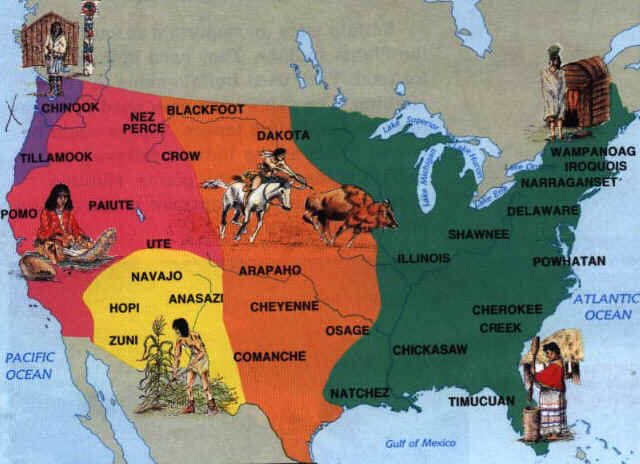
Learn more about Indian cultures at this great site:
THE INDIANS OF THE NEW WORLD
Learn more about Indian cultures at this great site:
The people now known as Indians or Native Americans were the first people to live in the Americas. They had been living there for thousands of years before any Europeans arrived.
The Vikings explored the east coast of North America around A.D.1000 and had some contact with Indians. But lasting contact between Indians and Europeans began with Christopher Columbus's voyages to the Americas. In 1492, Columbus sailed across the Atlantic Ocean from Spain. He was seeking a short sea route to the Indies, which then included India, China, the East Indies, and Japan. Europeans did not then know that North and South America existed. When Columbus landed in what is now known as the West Indies, he did not realize he had come to a New World. He thought he had reached the Indies, and so he called the people he met Indians.
Almost every Indian group had its own name. Many of these names reflected the pride of each group in itself and its way of life. For example, the Delaware Indians of eastern North America called themselves Lenape, which means genuine people. Today, many Indians refer to themselves as Native Americans.
Activity #1: Find out the meaning the names of other Indian groups.
Write your results on the spreadsheet below. Click on the links below for help.
Tribal Names and Meanings
Hopi - Ute - Makah - Illinois - Wampanoag - Mohawk - Nez Perce - Navajo
Activity #2: Imagine that you and your classmates are members of an Indian tribe.
What name would you give your group?
Keep in mind where you live and/or your qualities and goals.
No people lived in the Americas before the Indians arrived. The first Indians came to the New World from Siberia, in Asia. Most scientists think they arrived at least 15,000 years ago. At that time huge ice sheets covered much of the northern half of the earth. The Bering Strait, which today is a narrow area of water that separates Asia and North America, was easily walked across by the Indians who were following the animals that they were hunting. Much later this ice sheet melted and the land bridge became covered with water.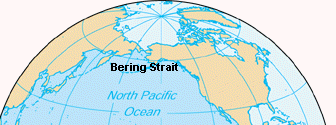 By then, Indian groups had already spread throughout the New World, all over North and South America. These Indian groups developed different cultures because of the different climates and landforms in the regions in which they settled.
By then, Indian groups had already spread throughout the New World, all over North and South America. These Indian groups developed different cultures because of the different climates and landforms in the regions in which they settled.
Anthropologists, scientists who study human culture, classify the hundreds of North and South American Indian tribes into groups of tribes that are alike. These groups are called culture areas. Some of the cultures of North America are the Arctic; the Northeast, or Eastern Woodlands; the Plains; and Southwest.
The Indians spoke hundreds of different languages and had many different ways of life. Some groups lived in great cities and others in small villages. Still others kept moving all year long, hunting animals and gathering wild plants.
The Aztec and the Maya of Central America built large cities. Some of the Aztec cities had as many as 100,000 people. The Maya built special buildings in which they studied the moon, the stars, and the sun. They also developed a calendar and a system of writing.
Many of the Indians of eastern North America lived in villages. They hunted and farmed, growing such crops as maize (corn), beans, and squash.
It is interesting to study the relations between the Indians and the explorers, the trappers, and the settlers who came from Europe. Most of the Indians were friendly at first and taught the newcomers many things. The European explorers followed Indian trails to sources of water and deposits of copper, gold, silver, turquoise, and other minerals. The Indians taught them to make snowshoes and sleds and to travel by canoe. Food was another of the Indians' important gifts. The Indians grew many foods that the newcomers had never heard of, such as avocados, corn, peanuts, peppers, pineapples, potatoes, squash, and tomatoes. They also introduced the whites to tobacco.
The Indians, in turn, learned much from the whites. The Europeans brought many goods that were new to the Indians. These goods included metal tools, guns, and liquor. The Europeans also brought cattle and horses, which were unknown to the Indians.
The Europeans and the Indians had widely different ways of life. Some Europeans tried to understand the Indians' ways and treated them fairly. But others cheated the Indians and took their land. When the Indians fought back, thousands of them were killed in battle. At first, they had only bows and arrows and spears, but the Europeans had guns. Even more Indians died from measles, smallpox, and other new diseases introduced by the whites.
As the Europeans moved westward across North America, they became a greater and greater threat to the Indian way of life. Finally, most of the remaining Indians were moved onto reservations.
Activity #3: On the spreadsheet below, list the things
the Indians introduced to the Europeans in Column A.
List the things the Europeans introduced to the Indians in Column B.
Activity #4: Answer the following questions:
Indian Family Life before the Europeans
Most daily activities of an Indian family centered on providing the main necessities of lifefood, clothing, and shelter. Some times of the year were busier than others. Among the salmon-fishing tribes of North America, for example, the spring and summer were the seasons for catching and storing fish. The winter was a relaxed time of year when many ceremonies and social gatherings were held.
Men and women usually had separate tasks. For example, both men and women were often involved in providing food. But they did so in different ways. In some areas, the women gathered wild plants for food, and the men hunted. In the Northeast and Southeast culture areas, the men hunted, and the women farmed the land. In parts of what are now Arizona and New Mexico and in Middle and South America, the men did the farming. The women gathered plants. In all areas, women were generally responsible for preparing the food.
Marriage: Many Indians married at an early agethe girls between 13 and 15 and the boys between 15 and 20. In some Indian tribes, the parents or other relatives chose the marriage partners for the young people. In other tribes, especially those of North America, a young man could select his own mate. He had to convince the girl and her parents that he would make a suitable husband. In many cases, he offered them valuable gifts to win their approval.
Activity #5: Imagine you are a teenage Indian youngster trying to win the approval of a future spouse and future in-laws. What would you say about yourself to convince them that you were a good catch? Your topic sentence could be: I know I would be a good husband/wife. Don't forget a closing statement. (Be creative. Don't simply write "That's why I would be a good husband/wife.")
Throughout most of the New World, marriage was a family affair and not a religious ceremony. The boy's family usually gave presents to the bride's family. Many newly married couples lived with the girl's familyand the husband worked for her familyuntil the birth of a child. Then the couple might establish their own home. But they generally did not move to a new home in a new area. Many other newly married couples joined an existing family group or lived close to one. Some of the couples moved in with other relatives of the woman or with the relatives of the man. This extended family shared with the daily work of the household, including the raising of children.
Many Indian groups allowed men to have more than one wife. But this practice was common only among rich or powerful men.
After a man died, his wife would often live with his brother as husband and wifeeven if the brother was already married. Similarly, if a woman died, her family would probably be expected to give her husband another unmarried daughter to replace her.
Children: Most Indian families were small because many children died at birth or as babies. But the youngsters usually had plenty of playmates. Many extended families included cousins, in addition to a child's own brothers and sisters.
Indian children were praised when they behaved well and shamed when they misbehaved. Only the Aztec and Inca tribes had regular schools. Boys and girls of other tribes learned to perform men's and women's jobs by helping their parents and older brothers and sisters. Games made Indian children skillful and strong.
After most boys reached their early teens, they went through a test of strength or bravery called an initiation ceremony. Many went without food for a long period or lived alone in the wilderness. In some tribes, a boy was expected to have a vision of the spirit that would become his lifelong guardian. Some groups also had initiation ceremonies for girls. A teen-ager who successfully completed an initiation ceremony was considered an adult and ready to be married.
Food: Food that Indians ate depended on where they lived. Indian tribes that lived on the plains of the United States, where buffalo and other game were plentiful, ate mainly meat. Meat was also the principal food of those Indians who inhabited the woodlands and tundra (frigid treeless plain) of Alaska and Canada. The Pueblo of the Southwest and other farming groups lived chiefly on beans, corn, and squash. Potatoes were an important crop among the Inca. Indians in the tropical areas of South America made bread from the roots of bitter cassava, a small shrub. Tribes that lived near water caught fish and gathered shellfish. Most Indian groups ate berries, nuts, roots, seeds, and wild plants. They also gathered salt and collected maple sap wherever they could.
Indians made a kind of tea from such plants as sassafras and wintergreen. Many Indians drank a mild beer that was known as chicha. They made this beer from corn, cassava, peanuts, or potatoes.
Indians who ate mostly meat cooked it by roasting, broiling, or boiling. Farming Indians and others who ate chiefly vegetables developed various methods of boiling or baking. They often made pit ovens by lining holes in the ground with hot stones. Indians preserved meat by smoking it or by drying it in the sun. North American Indians mixed dried meat with grease and berries to make a food called pemmican. Most Indians ate with their fingers, but some used spoons made from animal bones, shells, or wood.
Questions: 1. Find a synonym for the following words from the food section above:
main or most important= populated= abundant=
2. What two methods did the Indians use to preserve meat?
Clothing: Many Indians made their clothes from animal skins and fur. Tanned deer hide, called buckskin, was one of the most common clothing materials throughout North America. Indians also used buffalo hides, rabbit fur, and bird feathers. Some tribes of the Northwest made cloth of bark and reeds, and the Pueblo wove cotton cloth. The Aztec, Inca, Maya, and some Caribbean tribes wove beautiful cotton and woolen cloth.
Indians in the hot South American areas often wore no clothing at all. In many tribes, a man wore only a breechcloth, a narrow band of cloth that passed between the legs and looped over the front and rear of a belt. Women wore simple aprons or skirts. Indians in colder climates wore leggings, shirts, and robes. Some wore sandals or moccasins to protect their feet.
Shelter: Indians built many kinds of homes because they lived in different climates and had different building materials available to them. Those who moved about a great deal had simple shelters they could carry easily, or they built temporary shelters. Indians who stayed in one place built larger, more permanent homes. Some groups built large houses where many families lived together. Others had simple dwellings that housed only a few people. In some cases, shelter changed with the season. Some Indians in Canada built snow houses during the winter. But in the summer, they lived in tents made of animal hides. In the United States, these Indians are sometimes called Eskimos.
Many Indians built a pole framework and covered it with leaves or bark, like the dome-shaped wigwam of the Northeast. The Iroquois followed a similar method in building their large, rectangular long houses. Some of these houses were more than 100 feet long. The Apache used brush and matting to make simple wickiups. The Pawnee and some other North American tribes made earth lodges. Earth lodges had a log framework covered by brush, grass, and earth. In some cases, the Indians placed the framework over a shallow pit. Poles or logs covered with earth formed the Navajo hogan. The Plains Indians built tepees of buffalo skins. In other areas, the Indians covered their tepees with animal skins or with tree bark. Indians at the southern tip of South America also used skins to cover shelters called windbreaks, which were open on one side. The cliff dwellers and other Pueblo Indians used adobe (sun-dried bricks) to make "apartment houses."
Learn more about Indian homes:
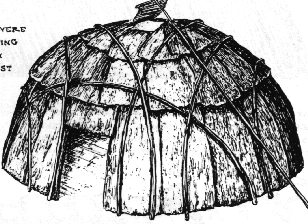 Learn more about wigwams:
Learn more about wigwams:
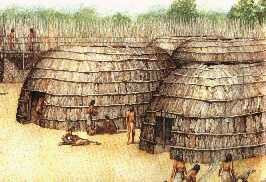 Learn more about longhouses:
Learn more about longhouses:
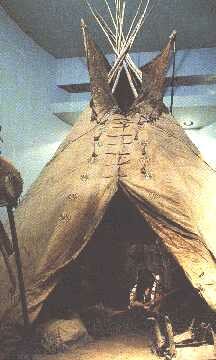 Learn more about tepees:
Learn more about tepees:
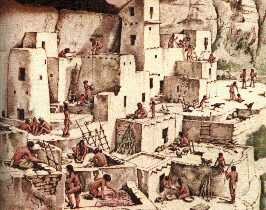
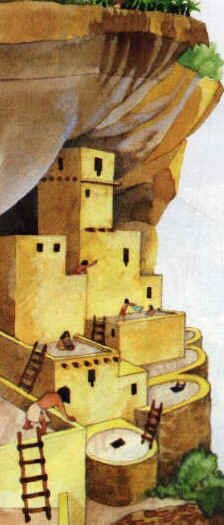
Learn more about cliff dwellings:
Hunting, gathering, and fishing: The animals hunted by the early Indians were very large. The hunters often found it easier to kill these beasts by driving them into swamps or over cliffs, rather than spearing them. Most of the knowledge that we have about the hunters comes from these sites where animals were killed.
Indians of the Arctic and the Northwest Coast and some other areas hunted or fished for most of their food. They also hunted some birds only for the feathers, and they prized the fur of beavers and certain other animals. Indians in the West got most of their food by gathering wild seeds, nuts, and roots. Even in the Southwest and other farming areas, hunting, gathering, and fishing were important.
The most important game animals of North and South America included deer; rabbits and other small game: ducks, geese, herons, seals, sea lions, whales, turtles, and snakes. Bear, buffalo, caribou, elk, and moose lived only in North America. Animals that were hunted mainly in South America included the guanaco, jaguar, peccary, rhea, and tapir.
Indians hunted with the same kinds of weapons they used in war. Many bows and arrows, spears, and clubs had special features for hunting. For example, some Indians used unsharpened arrows to shoot birds in trees. These arrows stunned the birds so that they fell to the ground. The Hopi stunned small game with a kind of boomerang.
The Indians caught fish with harpoons, hooks and lines, spears, and traps and nets. Tribes of the Northwest Coast also used long poles called herring rakes. These poles had jagged points and could catch a number of herring at one time. In tropical South America, Indians stood on river sand bars and shot fish with bows and arrows. Both North and South American Indians used drugs to catch fish. In one method, Indians chopped up certain plants and threw them in the water. These plants stunned the fish. Then the Indians could easily scoop them out of the water.
Farming by the Indians consisted mainly of growing corn, squash, and beans. Other crops included avocados, cacao, cassava, coca, cotton, guavas, peanuts, peppers, potatoes, tobacco, and tomatoes.
The farming tools of the tribes included pointed sticks for digging and hoes made of wood, stone, bone, or shell. Indians planted corn in small hills arranged in rows. Some tribes used dead fish to fertilize the soil. In the desert areas of the Southwest, the early Hohokam Indians dug long irrigation ditches to bring water to their crops.
Indians of the Northeast and the Tropical Forest used slash-and-burn farming methods. They cut down a number of trees and burned them. Then they planted their crops among the trunks. The ashes from the burned trees served as fertilizer.
Indians in Mexico and the Southern United States raised turkeys. South American Indians kept llamas and alpacas for food and wool and also used them as beasts of burden. Dogs were the only other tame animals in North and South America.
Transportation: Before the arrival of the Europeans, the Indians did not have horses, oxen, and most other beasts of burden used in other parts of the world. As a result, the Indians never developed the wheel, though they had discovered its principle. The Inca and Maya built excellent roads, but most other tribes used narrow trails.
Travel by water was the most common means of transportation. Many Indians used bark canoes, which were light and easy to carry. Some large dugout canoes carried as many as 60 people. Dugout canoes were made by burning out the centers of fallen trees with embers and then chopping out the charred wood with stone axes. Indians also made light boats of reeds. Plains Indians stretched buffalo skins over a round frame to make a bullboat. Indians of the snowy north developed snowshoes and toboggans. Some important Indian nobles traveled on wooden frames carried by servants.
Indians had few ways of carrying loads. The Plains tribes used dogs and, later, horses to pull a load-carrying frame called a travois truh VOY. Andean Indians used alpacas and llamas as beasts of burden. But these animals could not carry heavy loads, so the people themselves carried most of their goods. People often supported a heavy load on their back with a pack strap called a tumpline. The strap was attached to both ends of the pack and stretched across the forehead.
Recreation: Almost all Indians played games. Men and women usually played separately and had different games. Children played almost all the games that their parents enjoyed.
Footracing was popular in many areas. The Indians of Mexico and the Southwest sometimes ran over a 30-mile course. Indians played many different kinds of ball games. In almost all these games, the players were not allowed to touch the ball with their hands. Stickball developed into the game of lacrosse. Usually, only women played shinny, or shinty, a kind of field hockey that was common in North America. The Aztec and Maya played a ceremonial game in which the players tried to bounce a large, hard rubber ball through a high vertical ring with their hips. Scoring was so difficult that the game ended when either team scored. In some cases, the captain of the losing team was sacrificed to the gods.
In the hoop-and-pole game, the players rolled a hoop along the ground and threw spears or sticks at it. They scored according to where the spears hit. The Arapaho, for instance, cut four marks around the edge of the hoop. They tried to strike the rolling hoop so that the stick fell directly on or below a certain mark. Indians of the Southeast called this game chunkey and used a small stone ring as a target.
Many Indians enjoyed shooting arrows as a sport. They used several kinds of targets, including pieces of bark, woven grass, or an arrow stuck in a tree. Northern Indians enjoyed a game called snow snake, in which each player tried to slide a dart or spear farthest on snow or ice.
Quieter amusements included several games of chance. Guessing games were popular in North America. In the hand game, one or more players on a team held marked sticks in their closed fists. The players on the other side tried to guess where a certain stick was. The hiding side sang loudly to confuse the guessers, and both sides bet on the results.
Questions: Today sports are still an important form of recreation. People in the United States love both to participate in and to watch sporting events. We pay a lot of money to watch important games. Good players and coaches earn big salaries. This makes winning even more important!
#1 Which game played by the Indians most resembles basketball today?
#2 Why wouldn't you want to be the captain of a bad team for this game?
Warfare: Wars occurred from time to time among the tribes of the Americas. But not all tribes took part in warfare. Many tribes opposed fighting, and others were so small that they did not have enough warriors to fight a war. Many of the Indian leaders who tried to defend their tribes and land against the white people became famous warriors. They included King Philip, a Wampanoag; Pontiac, an Ottawa; Tecumseh, a Shawnee; Osceola, a Seminole; Crazy Horse, of the Sioux; and Geronimo, an Apache.
Weapons: The bow and arrow was probably the most common Indian weapon throughout North and South America. Some South American tribes put poison on their arrowheads. Many Indians fought with spears and war clubs. The Indians of eastern North America developed a special type of club known as the tomahawk. A weapon of the Aztec consisted of pieces of obsidian (volcanic glass) stuck into a wooden club. South American Indians used blowguns and slings.
Warfare gave Indians a chance to achieve high rank in their tribes. On the Plains, it was considered braver to touch a live enemy and get away than to kill the enemy. This act was known as counting coup koo. Warriors on the Plains carried a coup stick into battle and attempted to touch an enemy with it. Those warriors who counted coup wore eagle feathers as signs of their courage.
The scalp of an enemy was a war trophy in parts of North America. Some Europeans encouraged scalp hunting in North America by paying Indians who were friendly to the newcomers for the scalps of enemies. War honors and trophies for some South American Indians included skulls and shrunken heads, too.
Warfare increased greatly in all areas after the Europeans came. It became the main way of settling disputes between the Indians and the whites. The Europeans adopted the Indian style of warfareambush, surprise attack, and quick withdrawal. The Indians began to use the Europeans' guns and other weapons.
Arts and crafts: Native Americans worked in many arts and crafts. For the most part, the Indians tried to make everyday objects attractive as well as useful. Indians also produced various forms of oral and written literature.
Pottery: The Indians created a great variety of beautiful pottery. They made most of their pottery by the coil method, in which pieces of clay are rolled into slender strips and laid on top of one another in spiral fashion. The Indian artist sometimes kept the coils on the pottery as decoration but often scraped the surface smooth.
Inca potters made some of the finest pottery in the New World. The Aztec and Maya painted some of their pottery with scenes of religious ceremonies. In North America, the early Indians of the Mississippi Valley made fine bowls and jars, many in the shape of animals.
Basketry: Almost all Indian groups made baskets that they used to store and carry food. The Indians also wove fibers into mats and wall coverings, articles of clothing such as hats and sandals, and fish traps. Some baskets were woven so tightly that they could hold water.
Carving: Middle American Indians created elaborate carvings. They carved jade, onyx, quartz, and other materials. The Northwest Coast Indians made fine woodcarvings. The wooden masks they used in ceremonies had movable parts. They also carved house posts, grave markers, and totem poles.
Metalwork: The Andean people knew how to make bronze and how to cast, solder, and gild metals. The Caribbean Indians produced fine pieces of gold work. Some Indians hammered copper to form tools and weapons. They also cut hammered copper to decorate objects.
Questions: Look up the bold-faced words in the paragraph above.
Be prepared to explain what each word means. Go to this site to get your definitions.
Weaving: Weaving was most common in Mexico and farther south, but the Pueblo of the Southwest wove cotton cloth before the arrival of the Europeans. The Navajo became wool weavers later and became famous for their blankets and rugs. The Northwest Coast Indians made beautiful blankets of cedar fibers and mountain-goat hair. The Indians of the Southeast wove plant fibers so well that the early white settlers thought the material was actually cotton cloth.
Weaving was also an important art among the Inca. Their weaving of cotton and of alpaca, llama, and vicuna wool was so fine that it has not been improved uponeven with power looms.
Literature: Most Indian groups handed down their folk tales and poetry by word of mouth. Some North American Indians recorded some of their tribal songs on bark.
Religion: There was no single Indian religion, but certain religious beliefs were widespread. Most important was the belief in a mysterious force in nature, an unseen spirit power. This force could help them find food, heal the sick, and win wars.
The Indians in some areas greatly feared the ghosts of the dead. But few Indians gave much thought to life after death or the idea of a heaven.
The guardian spirit. One way of reaching the powerful spirit world was through a personal spiritual helper called a guardian spirit. The Indians believed that the spirit helped guide a person through the hardships of life. An individual might have one special guardian spirit, or different ones for different needs. Belief in a guardian spirit was common throughout most of the New World.
When boysand, in some tribes, girlsreached their early teens, they went through an initiation ceremony to help them find a guardian spirit. Many went without food, sleep, or companionship until they saw a vision of their guardian spirit. Some wounded themselves to help bring a vision. This search for a vision of a guardian spirit is known as a vision quest.
Shamans: The spirit world could also be reached with the aid of a religious helper called a shaman. The shaman was believed to have close contact with the spirit world. Shamans were sometimes called medicine men or medicine women because their tasks included treating the sick.
Some Indians believed that certain diseases were caused by an object in the body. Shamans began their cure for such conditions with special songs and movements. They usually blew tobacco smoke over the sick person because tobacco was believed to have magical powers. Shamans sucked on the body of the sick person until they "found" the object causing the illness. Then they spit out the objectusually a small stick or a stone that they had hidden in the mouth.
Shamans had some knowledge of medicine. They set broken bones and used various herb remedies. Many plants they used are still given by doctors today. Curare arrow poison is used in treating hydrophobia and tetanus. The Indians also used quinine, which physicians prescribe to treat malaria. The Inca developed trephining, the removal of part of the skull. This surgery was often used to relieve pressure on the brain.
Prophets: A new type of religious leader appeared among the Indians after the Europeans arrived. Most of the new leaders urged their followers to give up European goodsespecially liquorand return to the old ways of the Indians. Because these leaders predicted future events, the Europeans called them prophets.
Ceremonies: Native Americans held a number of kinds of ceremonies. Many of these rituals were designed to ensure that the Indians had enough food. Hunting tribes performed ceremonies to keep game plentiful. The Plains Indians, for example, believed that the buffalo dance would ensure success in hunting buffalo. Farming tribes held planting ceremonies, rain dances, and harvest festivals. The green corn dance of the Indians of the Southeast celebrated the summer's first corn crop. At the end of the Hopi snake dance, snakes were released to ask the rain god to send rain. Some ceremonies ended with a human sacrifice to the gods, especially those in Central and South America.
The sun dance was the chief ceremony of the Plains Indians. The Indians performed it to gain supernatural power or to fulfill a vow made to a spirit in return for special help. Some men tortured themselves as part of this ceremony. A sun dance lasted several days.
Nearly all Indian tribes of North and Middle America had some kind of a sweat lodge ceremony. This ceremony took place in a building called a sweat lodge. Some sweat lodges were heated directly by a fire. But in many lodges, water was poured over heated stones to produce steam. The hot steam caused occupants of the sweat lodge to perspire. Sweat lodge ceremonies were designed to purify the body, cure illnesses, and influence spirits.
Legends of gods, spirits, and ancestors were handed down from parent to child. Indian legends included stories of the world before it had people, stories of the origin of people and tribes, and tales of tribal heroes.
Money: The Indians had no formal system of money. For the most part, they traded goods and services for other goods or services. In some areas, the Indians used certain objects much as money is used today. In the West, sea shells called dentalia or tooth shells were divided into five sizes. The longer the shell, the greater was its value. Indians of Middle America used cacao beans, from which chocolate is made, as money.
In eastern North America, Indians sometimes used wampum. Wampum, a combination of purple and white beads made from shells, was strung into necklaces or belts. It served mainly as a means of keeping records or recording treaties. But because it had value, it was also used as money.
Trade between Indians and whites was important in North America. The settlers needed many of the things the Indians had, and the Indians wanted guns, horses, liquor, and metal tools. Both groups used beaver pelts and buffalo hides as items of trade in the northern areas and on the Plains.
Language: The Indians of North and South America probably spoke more than 2,000 languages at the time the Europeans arrived. Some had many similar words and grammar, but others differed greatly. Many Indian languages are lost because all the people who spoke them died before their languages could be recorded.
Writing: The most highly developed Indian writing systems included those of the Maya and the Aztec. Maya writing consisted of symbols called glyphs, which were carved in stone. The Maya also wrote on bark paper and deer hide. Most of the glyphs have been translated. Maya had a number system based on 20 and a symbol for zero. They used their numbers to create a calendar that may have been more accurate than those of the ancient Egyptians, Greeks, or Romans.
Aztec writing consisted of pictographs, most of which were pictures of objects. The Aztec used pictographs mainly to keep records. The Spaniards learned to read Aztec writing, which was still in use when they arrived.
The Inca kept records by tying knots on a string called a quipu. The quipu used the decimal system. The knots at the end each stood for 1, those farther up each counted for 10, and those still higher up stood for 100.
Some tribes used pictures or wampum to keep records. Pictures drawn on animal skins or bark showed events in a person's life or a tribe's history. The drawings also recorded the passage of time. Belts of wampum kept account of treaties.
In North America, a Cherokee named Sequoyah invented a writing system. This system consisted of symbols that stood for sounds in the Cherokee language. With 86 signs, he could write any Cherokee word.
Other communication: The Indian tribes of the Plains spoke many languages and needed some way to communicate with one another. This is how sign language developed.
Indians also used smoke signals and drum signals. However, these forms of communication could send only limited informationa warning, for example.
Some Indian Cultures Before and After the Europeans came:
Eastern Woodlands before the Europeans: The Northeast is a region of cold winters and warm summers. Forests cover much of this area. Many of the Indians in this culture lived by growing corn, beans, and squash. Slash-and-burn agriculture was the main method of farming. The women farmed and gathered wild plants, nuts, and berries. Men hunted and fished. Some of the northernmost groups depended more on hunting, gathering, and fishing than on farming. Indians in the Great Lakes region harvested wild rice, and some tribes collected the sap of maple trees.
Houses were made to protect people from the cold in winter. Most Northeastern Indians lived in villages of dome-shaped wigwams covered with bark. Iroquois villages included long houses with separate sections for related families. Tall fences called palisades surrounded many villages and provided protection from enemies.
The Indians of the Eastern Woodlands traveled on foot or in bark canoes. Northeastern Indians made deerskin shirts, dresses, leggings, and breechcloths. Many of these Indians rubbed their hair with bear grease to make it smooth and shiny. In some groups, men shaved their heads almost completely, leaving only a small tuft of hair on top.
Eastern Woodlands after the Europeans: The tribes of the Eastern Woodlands were among the first to meet European explorers and settlers. At first, the two groups had friendly relations. Squanto is said to have taught the white settlers how to plant corn and fertilize it with dead fish. Massasoit of the Wampanoag helped the Pilgrims of Plymouth Colony. In 1621, the Indians and Pilgrims joined in a Thanksgiving ceremony to give thanks for a good harvest and peace. But the friendly relations did not last, and warfare soon became common. Most of the early fighting consisted of small battles between settlers and Indians. Smallpox, measles, and other European diseases killed many Indians.
As the settlers moved westward, they took the Indian land for their own. Fighting started. Some of these battles grew into wars. The Northeastern Indians also became involved in the wars between France and Britain for possession of North America. The Indian tribes took sides in these wars and often ended up fighting each other as well as the white settlers.
Many tribes from the Eastern Woodlands now live in Oklahoma and various Western states. The U.S. government forced them to move to these areas during the early 1800's. But the Iroquois and some others still live on their original lands. Today, the Iroquois are leaders in the struggle for American Indian rights.
However, white Americans continued to desire Indian lands, and in 1830, Congress passed the Indian Removal Act. This allowed the U.S. government to move Indians living east of the Mississippi River to a territory west of the river. Thousands of Indians died during this forced removal to the West, later known as the Trail of Tears.
Indians of the Plains: The Plains stretch from west of the Mississippi River to the Rocky Mountains and from Canada to Mexico. Few Indians lived in this vast grassland region before the arrival of the Europeans. But after the Spaniards brought horses to the region in the 1600's, a new way of life appeared on the Plains. On horseback, the Indians could follow the great herds of buffalo. After new tribes and white settlers arrived on the Plains, fighting broke out.
Indians of the Plains Before European contact: Most of the original Plains tribes lived in villages along the rivers and streams where the land was fertile and easy to farm. Out on the grasslands, the tough sod was hard to farm. The women tended crops of beans, corn, squash, and tobacco while the men hunted deer, elk, and sometimes buffalo. During the summer, the Indians left their villages to hunt the vast buffalo herds on the Plains. The huge beasts were difficult to hunt on foot, and so the men tried to stampede herds of them off cliffs or into areas where they could be killed more easily. In the fall, the Indians returned to the villages and harvested their crops. They pulled the slain buffalo home on travois, which were made by fastening a platform to two poles. Sometimes the Indians used dogs to pull the travois.
The early Plains Indians wore deerskin breechcloths, leggings, and simple shirts. They used buffalo hides for winter robes and moccasin soles. While in their villages, the tribes lived in earth lodges, frames of logs covered with brush and dirt. Out on the Plains, they lived in tepees made of animal skins.
Indians of the Plains After European contact:: The coming of the horse and gun greatly changed life on the Plains. After the Spaniards brought horses to the region in the 1600's, a new way of life appeared there. On horseback, the Indians could follow the great herds of buffalo. With the horse, Indians could leave their villages and follow the buffalo herdswhich they could not do on foot. Buffalo meat became their main food. The flesh could be roasted over a fire, dried in the sun to make jerky, or pounded with berries and suet to make pemmican. The Indians used buffalo skins to make clothing, bedding, and tepees. They made the bones and horns into tools and utensils and used dry buffalo manure for fuel. The tribes held many ceremonies aimed at assuring a large enough supply of buffalo.
The tribes on the eastern Plains, sometimes called the Prairies, continued to farm part of the year and to live in earth lodges. But on the western Plains, daily life became centered on the vast buffalo herds. The buffalo hunters stayed on the move continually. As a result, large tepees, which could be moved from camp to camp, replaced earth lodges as their main home. The Indians used horses to haul their possessions on large travois. A good buffalo hunter might have two or more wives to prepare all the buffalo hides he brought home.
Nearby tribes, and those forced westward by the white people, quickly followed the Plains way of life. New tribes to arrive on the Plains were the Arapaho, Blackfeet, Cheyenne, Comanche, and Sioux.
With many new tribes in the same area, they needed a language they could all understand. That is how Indian sign language started.
Now there were many new tribes and white settlers in the same area. Fighting broke out. Tribes fought with each other and with the whites. Success in warfare earned fame for a warrior. Counting coup won the highest honor. After battle, the warriors told of their heroic deeds and celebrated their victory. Eagle feathers were awarded for bravery.
The widespread killing of buffalo, particularly by white hunters, endangered these huge animals. By 1890, the buffalo herds had almost disappearedand with them, the Plains way of life. In their place came increasing numbers of ranchers and settlers who turned the Plains into cattle ranches. The federal government moved many tribes onto reservations and hoped they would take up farming. But the Plains Indians considered farming to be the work of women or white people. They turned instead to warfare and to religious movements.
The last major battle between the Plains Indians and the U.S. Army took place in 1890. Federal troops trapped and massacred as many as 300 Sioux men, women, and children at Wounded Knee in South Dakota.
Indians of the Southwest Before European Contact: The Southwest, a huge, dry region, includes Arizona, New Mexico, parts of Utah, Colorado, and Mexico. In the northern section, wind and water have formed steep-walled canyons, sandy areas, buttes, mesas, and other landforms. In the south, the mountains give way to flat, desert country.
The early Indians of this area, like the Anasazi, built cliff houses. Hohokam dug long irrigation canals. The Pueblo tribes, descendents of the early Anasazi Indians, had one of the most highly developed civilizations in North America. Most Pueblo lived in villages and farmed along rivers that provided enough water for irrigation. Their namePueblocomes from the Spanish word for village.
The Pueblo depended on corn, beans, and squash for most of their food. They also raised turkeys. Water was important to them because enough rain meant the difference between plenty of food and starvation. Throughout the year, the Pueblo held religious festivals and ceremonies that were aimed at bringing rain and making their crops grow.
The Pueblo were excellent craft workers. The women made beautiful decorated pottery.They spun yarn from cotton that they grew and wove it into cloth. The men wore cotton breechcloths and cotton kilts. Women wrapped cotton cloth around their bodies and fastened it under the left arm and over the right shoulder. Around their legs they wore buckskin wrappings that reached to the top of their moccasins. After the Spaniards introduced sheep to the Southwest, the Pueblo began to weave woolen cloth for clothing.
The Pueblo built large, many-storied homes of adobe and rocks. These dwellings housed many familiesand some held an entire village. The people usually entered by ladders through the roof. The ladders could be removed in case of enemy attack. They provided protection from the frequent raids by the Apache and Navajo. Sometimes the Pueblo built their dwellings into the sides of steep cliffs, which provided additional protection against attack.
The Pueblo usually fought only when attacked. If a Pueblo killed someoneeven in warfarethat individual had to go through a long period of self-purification before returning to live in the village.
The Apache and Navajo, on the other hand, were fierce fighters. These two groups attaccked the Pueblo in search of food and goods. The Navajo and Apache both learned some farming from the Pueblo, but they depended chiefly on hunting and gathering for their food. They hunted game, including deer, pronghorns, and rabbits, and gathered cactus fruit, roots, and other plant food.
The Navajo and Apache wore skin garments. The Navajo later began loom weaving like the Pueblo Indians. A Navajo family lived in a mud-covered log hogan. The Apache did not have permanent houses. Some of these Indians lived in brush shelters, and others lived in tepees.
Indians of the Southwest After European Contact: Coronado, a Spanish explorer, was one of the first Europeans to meet the Southwest Indians while searching for the Seven Cities of Gold. Soon afterward, the Spaniards established Roman Catholic missions among the Pueblo. The Spaniards attempted to teach the Indians Christianity. They were not allowed to perform rainmaking ceremonies. However, the Indians continued to practice their old religion, and the Spaniards punished them. Many Pueblo people were killed.
The Pueblo revolted and the Spaniards again conquered them. Many Pueblo fled to live with the Navajo and other Southwest Indians.
The Navajo learned new waysboth Pueblo and Europeanfrom the Pueblo. These included fruit growing, sheep raising, and cloth weaving. The Navajo also adopted Pueblo religious practices, such as chanting, masked dancing, and sand painting. Sand painting, sometimes called dry painting, became an important part of Navajo curing ceremonies. In sand painting, grains of sand, ground-up minerals, and seeds of various colors are arranged into designs.
Today, the Navajo are one of the largest Indian groups in the United States. Many live on a reservation in Arizona. The Navajo have become noted for weaving blankets and rugs and making silver jewelry. Some raise sheep and cattle, but the land is dry and overgrazed. The Apache became famous for their bravery and fierce fighting. Most of the remaining Apache also live on reservations. The Pueblo never completely gave up their religious practices, even under Spanish rule. Theyand most Southwestern Indianshave been successful through the years in preserving their traditions.
Indians of Central America Before European Contact: These Indians were the first farmers of the New World. Agriculture probably began by about 7000 B.C. When they began to grow corn, beans, squash, and other crops permanent villages began to appear. With farming, the land could support a large population, and some of the people were freed from the continual search for food. More time could be spent in arts and crafts, trade, government, and religion. Great cities grew, and the Maya and the Aztec civilizations became two of the most highly developed in the Americas.
Around A.D. 500, Teotihuacan became the largest Indian city of the ancient Americas. It has a large population like those of Europe and Asia at the time. The ruins of this great city's pyramids, palaces, and apartment complexes can still be seen near Mexico City.
Farmers used raised fields and terraced hillsides to make the most of their fertile land. Middle American Indians built houses of poles and covered them with roofs made of leaves and grass. Some houses had roofs made of mud.
The Aztec controlled the Valley of Mexico and the surrounding area from the 1400's until the Spaniards conquered them in 1521.
A king, chosen from a noble family, ruled the Aztec. He was aided by a council of important people and priests. They often sacrificed prisoners to the gods.
Tenochtitlan was the Aztec capital. When Cortes and his Spanish troops arrived in there in 1519, the city had a large population.
Indians of Central America After European Contact: Montezuma ruled the Aztec when Cortes landed there. The Spaniards conquered large armies of Indians along the coast of Mexico who had never seen cannons or horses. As Cortes moved inland, toward the capital, he added these tribes to his army. These Indians hated the Aztec. The Aztec had seized food and goods from these tribes and had sacrificed captives to the gods.
Montezuma did not fight the Spaniards as they came close. Some people think he feared Cortes might be a god. Cortes entered Tenochtitlan and made Montezuma a hostage. The Spaniards treated the Aztec people badly and destroyed their beautiful city. Thousands of Aztec were killed.
Question: Have you ever heard of Montezuma's revenge? What does it mean? Go here for help. How do you think this expression came into our language?
Diseases brought by the Spaniards killed many Indians, and the Spaniards made slaves of many others. Missionaries tried to convert the Indians to Roman Catholicism. Many Indians adopted the new religion, but they combined it with a number of their old beliefs.
The Destruction of Indian America:
The arrival of Europeans in the Americas marked the beginning of the end of the way of life many Indians had known for centuries. Waves of European explorers, fur traders, missionaries, and settlers swept across the New World. Many settlers thought they were better than the Indians and tried to force Indians to adopt their ways. Missionaries tried to convince Indians to become Christians.
Land became a major issue between the Europeans and the Indians. The settlers wanted the land for farming, for grazing cattle, and for mining. They believed in the ownership of land. Most Native Americans, on the other hand, generally considered themselves caretakers of the land. They believed that they did not own the land individually and therefore had no right to sell it or give it away. When Indians "sold" land, they might believed they were only agreeing to let the whites use it. The Indians expected to keep hunting or farming there. When the settlers tried to keep the Indians off what the settlers now considered their property, fighting broke out. Through the years, more and more Indians were forced off their land as more and more newcomers arrived.
In Canada. During the 1500's, early French explorers claimed eastern Canada for France. The French were interested mainly in establishing trade with the Indians, and the two groups had relatively good relations. Some French traders married Native American women.
During the 1600's, English colonists began to move into eastern Canada. They claimed the land for England, and conflicts broke out between the English and the French. Between 1689 and 1763, the French and English fought four wars for control of North America. During these wars, some tribes sided with the French and others with the English. The wars ended with British victories, and as a result, Native American tribes came under British control.
In the United States: Most of the early English settlers who came to what is now the United States wanted to start new lives and make new homes for their families. At first, the British and colonial governments tried to deal with the Indians through negotiation and treaties. The settlers and the Indians had fairly friendly relations. But as the Indians sought to protect their land from the claims of increasing numbers of newcomers, fighting broke out between the two groups.
After the Thirteen Colonies declared their independence from Britain, the government of the new United States became responsible for dealing with the Indians. In 1778, the United States and the Delaware Indians signed a treaty. Tribes agreed to keep peace with the settlers and to recognize the control of the U.S. government. Each tribe gave up much of its territory and kept only a part for itself. The federal government promised a cash payment and protection in return for the land it obtained from the tribe. In most cases, the government also agreed to supply the Indians with livestock, manufactured goods, and medicine.
Under the U.S. Constitution, treaties with Indian tribes were as legally binding as agreements with other nations. But many of the treaties were broken as increasing numbers of settlers entered lands reserved for the Indians.
Indian removal: In 1830, Congress passed the Indian Removal Act. This act was designed to free more eastern land for white settlement. It allowed the president to move the eastern Indian tribes to land west of the Mississippi River.
United States military supervised the Indian groups as they were forced westward. Thousands of Indians died on this journey, called the Trail of Tears.
Treaties with the United States guaranteed the Western lands to the Indians who had moved from the East. Eventually, however, settlers wanted that land as well, and the territory began to shrink. Meanwhile, settlers were pushing into other Indian lands in the West all the way to the Pacific Ocean. The discovery of gold in California in 1848 also brought prospectors who killed the game on which many Western tribes depended. The Indians fought to keep their lands but were finally defeated. The U.S. government placed the various tribes on reservations, mainly in the West.
The government hoped to encourage the Indians to become farmers. But many Indians had no knowledge of farming, and others had no interest in it. Also, much of the land given to the Indians was unsuitable for growing crops. Many Indians sold their lands and lived off the money they received. When that money ran out, the Indians had no means of support. Then some white people settled illegally on Indian lands, and the government had difficulty evicting them. In addition, many Indians were also cheated out of their land by dishonest whites.
Lenape website: http://www.delawaretribeofindians.nsn.us/
Lenape design:

Graph paper:

